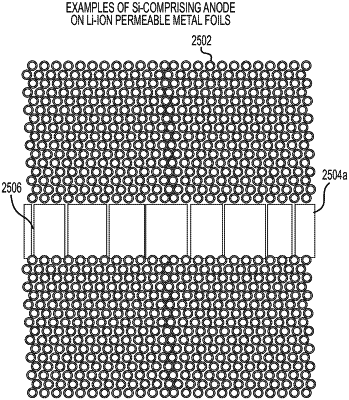| CPC H01M 4/386 (2013.01) [H01M 4/134 (2013.01); H01M 4/136 (2013.01); H01M 4/364 (2013.01); H01M 4/366 (2013.01); H01M 4/58 (2013.01); H01M 4/62 (2013.01); H01M 4/66 (2013.01); H01M 4/661 (2013.01); H01M 4/668 (2013.01); H01M 4/72 (2013.01); H01M 10/0445 (2013.01); H01M 10/0525 (2013.01); H01M 10/0587 (2013.01)] | 21 Claims |

|
1. A Li-ion battery cell, comprising:
a composite current collector comprising pores;
a second current collector;
a Li-ion permeable anode on the composite current collector;
a Li-ion permeable cathode on the second current collector;
an electrolyte comprising an organic solvent ionically coupling the anode and the cathode; and
a separator electrically separating the anode and the cathode;
wherein the anode comprises a composite active material composition, the composite active material composition comprising first active material particles that exhibit specific capacity of at least 400 mAh/g and second active material particles comprising graphite that exhibit specific capacity that is less than or equal to 372 mAh/g; and
wherein at least some of the second active material particles are in the pores of the composite current collector as part of a filler material;
wherein at least some of the first active material particles are electrically connected to the composite current collector and are outside of the pores of the composite current collector; and
wherein the pores are smaller than the first active material particles.
|